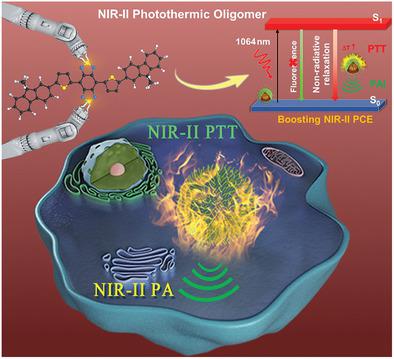当前位置:
X-MOL 学术
›
Adv. Mater.
›
论文详情
Our official English website, www.x-mol.net, welcomes your feedback! (Note: you will need to create a separate account there.)
Rational Design of Conjugated Small Molecules for Superior Photothermal Theranostics in the NIR-II Biowindow.
Advanced Materials ( IF 29.4 ) Pub Date : 2020-07-06 , DOI: 10.1002/adma.202001146 Shengliang Li 1 , Qingyuan Deng 2 , Yachao Zhang 3 , Xiaozhen Li 1 , Guohua Wen 3 , Xiao Cui 1 , Yingpeng Wan 1 , Yongwei Huang 2 , Jiaxiong Chen 1 , Zhonghua Liu 2 , Lidai Wang 3 , Chun-Sing Lee 1
Advanced Materials ( IF 29.4 ) Pub Date : 2020-07-06 , DOI: 10.1002/adma.202001146 Shengliang Li 1 , Qingyuan Deng 2 , Yachao Zhang 3 , Xiaozhen Li 1 , Guohua Wen 3 , Xiao Cui 1 , Yingpeng Wan 1 , Yongwei Huang 2 , Jiaxiong Chen 1 , Zhonghua Liu 2 , Lidai Wang 3 , Chun-Sing Lee 1
Affiliation

|
Extensive recent progress has been made on the design and applications of organic photothermal agents for biomedical applications because of their excellent biocompatibility comparing with inorganic materials. One major hurdle for the further development and applications of organic photothermal agents is the rarity of high‐performance materials in the second near‐infrared (NIR‐II) window, which allows deep tissue penetration and causes minimized side effects. Up till now, there have been few reported NIR‐II‐active photothermal agents and their photothermal conversion efficiencies are relatively low. Herein, optical absorption of π‐conjugated small molecules from the first NIR window to the NIR‐II window is precisely regulated by molecular surgery of substituting an individual atom. With this technique, the first demonstration of a conjugated oligomer (IR‐SS) with an absorption peak beyond 1000 nm is presented, and its nanoparticle achieves a record‐high photothermal conversion efficiency of 77% under 1064 nm excitation. The nanoparticles show a good photoacoustic response, photothermal therapeutic efficacy, and biocompatibility in vitro and in vivo. This work develops a strategy to boost the light‐harvesting efficiency in the NIR‐II window for cancer theranostics, offering an important step forward in advancing the design and application of NIR‐II photothermal agents.
中文翻译:

NIR-II生物窗中共轭小分子的优异设计,以实现优异的光热治疗学。
由于与无机材料相比,它们具有优异的生物相容性,因此在生物医学应用的有机光热剂的设计和应用方面已取得了广泛的进展。进一步开发和应用有机光热剂的一个主要障碍是第二近红外(NIR-II)窗口中高性能材料的稀有性,它可以使组织深层渗透并减少副作用。到目前为止,几乎没有报道过的NIR-II-活性光热剂,它们的光热转换效率相对较低。在这里,π共轭小分子从第一个NIR窗口到NIR-II窗口的光吸收是通过取代单个原子的分子手术精确调节的。用这种技术 首次展示了吸收峰超过1000 nm的共轭低聚物(IR-SS),其纳米粒子在1064 nm激发下实现了创纪录的77%的高光热转换效率。纳米粒子在体外和体内显示出良好的光声响应,光热治疗功效和生物相容性。这项工作制定了提高癌症治疗学在NIR-II窗口中的光收集效率的策略,为推进NIR-II光热剂的设计和应用迈出了重要的一步。和体外和体内生物相容性。这项工作制定了提高癌症治疗学在NIR-II窗口中的光收集效率的策略,为推进NIR-II光热剂的设计和应用迈出了重要的一步。和体外和体内生物相容性。这项工作制定了提高癌症治疗学在NIR-II窗口中的光收集效率的策略,为推进NIR-II光热剂的设计和应用迈出了重要的一步。
更新日期:2020-08-18
中文翻译:

NIR-II生物窗中共轭小分子的优异设计,以实现优异的光热治疗学。
由于与无机材料相比,它们具有优异的生物相容性,因此在生物医学应用的有机光热剂的设计和应用方面已取得了广泛的进展。进一步开发和应用有机光热剂的一个主要障碍是第二近红外(NIR-II)窗口中高性能材料的稀有性,它可以使组织深层渗透并减少副作用。到目前为止,几乎没有报道过的NIR-II-活性光热剂,它们的光热转换效率相对较低。在这里,π共轭小分子从第一个NIR窗口到NIR-II窗口的光吸收是通过取代单个原子的分子手术精确调节的。用这种技术 首次展示了吸收峰超过1000 nm的共轭低聚物(IR-SS),其纳米粒子在1064 nm激发下实现了创纪录的77%的高光热转换效率。纳米粒子在体外和体内显示出良好的光声响应,光热治疗功效和生物相容性。这项工作制定了提高癌症治疗学在NIR-II窗口中的光收集效率的策略,为推进NIR-II光热剂的设计和应用迈出了重要的一步。和体外和体内生物相容性。这项工作制定了提高癌症治疗学在NIR-II窗口中的光收集效率的策略,为推进NIR-II光热剂的设计和应用迈出了重要的一步。和体外和体内生物相容性。这项工作制定了提高癌症治疗学在NIR-II窗口中的光收集效率的策略,为推进NIR-II光热剂的设计和应用迈出了重要的一步。


























 京公网安备 11010802027423号
京公网安备 11010802027423号